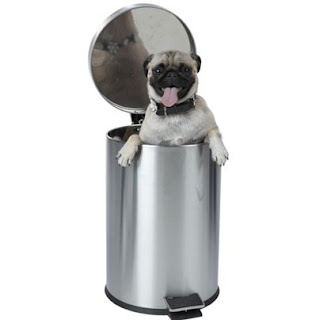Why worry?
Because people food is not safe for animals. And food isn’t the only
risk—animals will eat the most unexpected things. It’s important to guard that
garbage can.
“You don’t
want your dog to pig out on chocolate or leftover pizza, chicken or
turkey—anything with a high percentage of fat can lead to pancreatitis
(inflammation and swelling of the pancreas, which can cause permanent damage
and be fatal)," says Martha Gearhart, DVM, owner of Pleasant Valley Animal
Hospital, Pleasant Valley, N.Y. “Raw bones are digestible, but their sharp
points are dangerous, and cooked bones are very brittle and can shatter [once
eaten].”
The odor
of food or blood attracts animals to garbage, sometimes with tragic
results—Gearhart’s brother’s dog ate the plastic wrap and Styrofoam tray from a
package of meat, killing the dog. “It didn’t show up in the X-ray, but the
points from the Styrofoam punctured the lung,” she recalls.
Boredom
and separation anxiety can make animals explore trash cans or pounce on
decorations, Gearhart says. “Some dogs have a passion for salty, smelly socks!”
she notes. “I had one dog that enjoyed knocking down glass ornaments and biting
on decorative balls.”
Cats
eating tinsel is so common that tinselitis is a veterinary term. “Cats
won’t eat tinsel from the garbage can, but will be attracted to tinsel on a
tree,” warns Gearhart.
I
discovered that myself—my own cat once ate tinsel. I found out when she
eliminated it, tangled in balls of poop that she dragged around the apartment.
I was lucky to get her to the veterinarian in time for treatment.
Dogs may
eat used tampons or sanitary pads, which cause dangerous internal obstructions,
Gearhart says.
There is
string in a roast or bird, and string is severely dangerous—it causes internal
damage. Cats are more likely to eat string than are dogs, notes Gearhart.
Prevention
First
Prevention
is the best way to protect animals from garbage:
- Rinse wrappers,
containers and packaging before pitching them.
- Lock garbage under the
sink or on the porch.
- Use trash cans with
tight-fitting lids (heavy, self-closing cans for households with large
dogs).
- Move garbage from indoors
to well-secured outdoor containers.
- Put tinsel and breakable
decorations high up, out of reach.
- Put a decorated tree in a
room with a door—and keep it closed.
- Keep dogs away from
dangerous and tempting situations.
As
Gearhart notes, “I’m all for crate training. They feel better and more secure.”
Protective
Measures
If
precautions fail, the best thing to do is call your veterinarian, who might
have you come in to get a vomit-inducing drug. Or, they may encourage you to
induce vomiting, unless the animal ate something sharp, acidic or caustic.
In some
instances, your veterinarian might have you wait—it can take up to 5 days for
elimination. Regardless, work with your veterinarian to find the best “cure”
for your pet.
Here’s to
a safe diet, and holiday season, for your animals!
Readers:
Tell us what your pet has gotten into by e-mailing the editor at ann.everhart@aahanet.org.


No comments:
Post a Comment